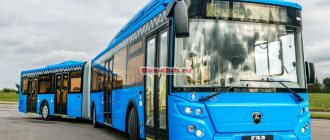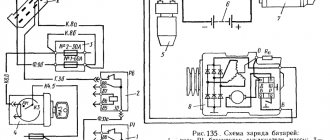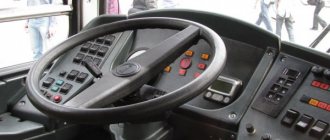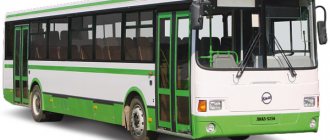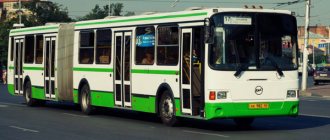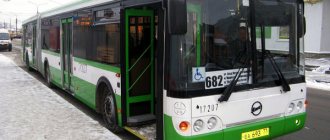Home Brands LiAZ LiAZ-5293
The LiAZ-5293 bus is a large, semi-low-floor bus for transporting passengers on city routes. The demand for low-floor and semi-low-floor buses is increasing every year. This is due to the convenience of loading and unloading passengers, which, in addition to comfort, also saves time. The time saved on boarding and disembarking passengers allows the driver to make another trip, which will bring additional profit. Therefore, large municipal organizations purchase such buses. And the production of this model is due to the fact that the company’s management follows global trends.
The bus itself combines acceptable environmental standards, pleasant appearance and optimal comfort for both the driver and passengers.
The platform of the new bus was LiAZ-5256, and the previous semi-low-floor model was called LiAZ-5292, but to say that LiAZ-5293 was its predecessor would be incorrect, since it was created only to reduce the cost of the model.
The model was shown in 2005, and the first copy rolled off the assembly line in 2006. To date, about 2,000 buses have been produced. Surprisingly, his presentation took place in Nizhny Novgorod, and not in Moscow, as is usually the case.
Dimensions
The model has a simple design with a large glass area. There are three doors for easy entry and exit. Since the bus is a large class bus, it has appropriate dimensions.
Dimensions:
- Length is 11400 mm;
- The bus turned out to be quite miniature in its width, which, without taking into account the side rear-view mirrors, is only 2.5 meters;
- Height – 3060 mm, but if you purchase a modification with a gas power plant, the overall height of the bus increases to 3322 mm;
- The wheelbase of LiAZ-5293 is 5840 mm;
- To turn, you will need a radius of at least 11500 mm;
- The curb weight is 10.5 tons, but the vehicle can be fully loaded up to 17.7 tons.
There are five modifications in total, two of which have already been discontinued due to non-compliance with Euro standards of the current period.
- 5293.00 – produced from 2006 to 2010.
- 5293.53 – from 2010 to 2012.
Currently, the following three modifications are available:
- 5293.54;
- 5293.60;
- 5293.70
Contents Repair instructions for LiAZ-5256 buses
CONTENTS OF THE BOOK REPAIR AND MAINTENANCE MANUAL FOR LIAZ-5256 BUSES
PREFACE 7 INTRODUCTION 8 Chapter 1. GENERAL INFORMATION 10 Safety requirements 11 General requirements 11 Safety requirements when starting the engine 11 Safety measures when starting, driving and parking 12 Safety measures during maintenance and repair 13 Safety measures when towing a bus 13 Technical characteristics 14 Management bus 19 Controls and monitoring devices 19 Starting the engine 29 Stopping the engine 34 Starting movement 34 Driving mode 35 Braking 37 Stopping and parking 39 Towing 40 Control of the liquid heater. 41 Running in a new bus 41 Maintenance 42 Types of maintenance 42 Maintenance frequency 43 Storage and preservation rules 44 Storage rules 44 Preservation 44 Depreservation 45 Chapter 2. KAMAZ-7408.10 ENGINE 46 General information 46 Block, liners and cylinder heads 46 Crank mechanism 49 Gas distribution mechanism 51 Drive units 53 Lubrication system 54 Fuel supply system 59 Air supply system 76 Gas exhaust system 77 Cooling system 77 Power unit suspension 85 Maintenance features 87 Checking the oil level in the Engine crankcase 87 Replacing the oil in the engine crankcase 87 Replacing oil filter elements fine filter 88 Washing the rotor of the centrifugal oil purification filter 88 Adjusting the thermal clearances in the gas distribution mechanism 89 Checking and adjusting the fuel injection advance angle according to the marks 90 Removing the cylinder head 91 Installing the cylinder head 91 Removing the injection pump 92 Installing the injection pump 92 Adjusting the injection pump on the stand 93 Adjusting the automatic clutch fuel injection advance 98 Removing, disassembling and servicing the injector 99 Assembling and installing the injector 100 Adjusting the injectors on the stand 100 Changing the oil in the automatic fuel injection advance clutch 101 Servicing the coarse fuel filter 101 Washing and replacing the filter elements of the fine fuel filter 102 Washing the fuel tank 102 Air filter maintenance 102 Checking the tightness of the air path 103 Maintenance of the cooling system 104 Maintenance of the electric flare device (EFD) 105 Chapter 3. CAT 3116 ENGINE 106 General information 106 Cylinder block and cylinder head 108 Crank mechanism 109 Gas distribution mechanism 109 Lubrication system 11 0 Fuel supply system 115 Air supply and exhaust gas systems 129 Cooling system 136 Power unit suspension 139 Maintenance features 141 Changing the oil in the engine crankcase 141 Replacing oil and fuel filter elements 141 Features of fuel injection 142 Maintenance of the coarse fuel filter (if equipped) 142 Maintenance of the water separator - coarse filter 142 Washing the fuel tank 142 Servicing the air filter 142 Checking the tightness of the intake air tract 143 Servicing the cooling system 143 Setting the piston of the first cylinder to top dead center (TDC) 143 Adjusting the uniformity of fuel supply to the injectors (synchronizing the operation of the injectors) 144 Adjusting the fuel dosage 148 Synchronization fuel supply 153 Adjusting the clearances in the valve mechanism 157 Separate check of the engine cylinders 158 Checking the engine readiness for starting 159 Chapter 4. KAMAZ-142 CLUTCH 160 General information 160 Design 160 Maintenance features 166 Adjusting the free play of the clutch pedal 166 Adjusting the free play of the clutch release 167 Control of the fluid level in the tank 167 pumping a hydraulic drive of the clutch 167 drain condensate from the pneumohydraulic amplifier 168 replacement of pneumohydraulic amplifier 168 Removal and installation of clutch 168 possible malfunctions and methods for their elimination 170 Chapter 5. Clutch of the company LIPE 172 General Keeping 172 Staff of maintenance 180 Capacity 180 Vigilance checks to complete disengagement 180 Bleeding the clutch hydraulic drive 180 Checking the condition of the clutch 183 Replacing (repairing) components and parts, adjusting the clutch 183 Adjusting the amount of movement of the fork pin of the clutch release mechanism (pneumatic power steering rod) 187 Possible malfunctions and methods for eliminating them 187 Chapter 6. KAMAZ TRANSMISSION 141 189 General information 189 Design 190 Maintenance features 202 Checking the oil level in the gearbox housing 202 Changing the oil in the gearbox 202 Checking the tightness of the corrugated cable covers 202 Removing and installing cables 203 Possible malfunctions and methods for eliminating them 204 Chapter 7. TRANSMISSION S6- 85 (ZF) 205 General information 205 Design 206 Maintenance features 216 Changing the oil in the gearbox 216 Cleaning the gearbox breather 217 Servicing the gear shift cable drive 217 Possible malfunctions and solutions 218 Chapter 8. HYDROMECHANICAL TRANSMISSION D851.2 VOITH 219 General information 219 Installation of the GMF on the KamAZ-7408.10 engine 219 Installation of the GMF on the Cat 3116 engine. 219 Maintenance features 220 Adjusting the position of the load sensor and the kickdown sensor 220 Monitoring the oil level in the GMF crankcase. 223 Replacing the oil in the GMT crankcase 223 Replacing the filter element of the GMT oil filter 224 Driver actions in the event of a GMT failure 225 Possible malfunctions and methods for eliminating them 226 Chapter 9. TRANSMISSION CARDAN TRANSMISSION 227 Design 227 Features of maintenance 228 Possible malfunctions and methods for eliminating them 229 Chapter 10. REAR AXLE 230 General information 230 Design 230 Maintenance features 238 Checking the oil level 238 Checking and adjusting the play in the rear wheel hub bearings 239 Checking the tightness of the rear axle 240 Checking and adjusting the play of the drive shaft flange 240 Cleaning the rear axle breather 242 Changing the oil in the main gear and in wheel gearboxes 243 Possible malfunctions and ways to eliminate them 244 Chapter 11. SUSPENSION 246 Design 246 Features of maintenance 254 Checking the condition of the reaction rods 254 Checking the correct location of the front axle beam 254 Checking the correct location of the rear axle 254 Checking the functionality of the body position regulator 254 Adjusting the height of the bus floor 255 Possible malfunctions and methods for their elimination 256 Chapter 12. FRONT AXLE 259 Design 259 Maintenance features 261 Lubricating the pivot pins 261 Checking the condition of the pivot units 261 Disassembling and repairing the pivot unit 262 Checking the condition of the front wheel hub bearings 263 Checking the condition of the front wheel hub oil seals 264 Lubricating the front wheel hub bearings 264 Adjusting the toe of the front wheels. 265 Checking wheel alignment angles 266 Possible malfunctions and ways to eliminate them 266 Chapter 13. WHEELS 267 Design 267 Maintenance 269 Daily maintenance (EO) 269 First maintenance (MOT-1) 269 Second maintenance (MOT-2) 270 Tire installation 270 Inflating tubeless tires 273 Removing tires 275 Removing wheels from a bus 275 Installing wheels on a bus 276 Chapter 14. STEERING 278 Design 278 Maintenance features 289 Checking the free play of the steering wheel 289 Maintenance of the bevel gear 290 Maintenance of the steering mechanism 291 Maintenance of the power steering with hydraulic system 292 Possible malfunctions and ways to eliminate them 293 Chapter 15. BRAKES 295 Brake mechanisms 296 Brake chambers 300 Bus pneumatic system 305 Air supply system 311 Pneumatic brake drive 323 Maintenance features 338 Maintenance of the brake drive pneumatic system 338 Checking the performance of the compressor 342 Checking the pneumatic system as a whole 344 Checking the circuit s drive workers brakes of the rear axle (I) and front axle (II) 345 Checking the drive circuits of the parking brake (Sha) and emergency brake release (Shb) 346 Checking the circuit of additional consumers (IV) 347 Servicing the brake mechanism 347 Servicing the brake chambers 354 Possible malfunctions and methods for eliminating them 357 Malfunctions of the brake mechanisms 357 Malfunctions of the pneumatic system 359 Chapter 16. ELECTRICAL EQUIPMENT AND INSTRUMENTS 363 Electrical supply system 365 Batteries 365 Generator set 367 Remote battery (ground) switch 370 Engine control system 373 Engine start control 373 Engine stop control 381 KamAZ engine thermal start system -7408.10 384 Intake air heater for CAT 3116 engine 386 Auxiliary engine brake control (for LiAZ-525625 bus with manual transmission) 387 GMP control system 387 Lighting system 388 External lighting 389 Lighting of route signs and door openings 394 Interior lighting 394 Service lighting 396 Alarm system and control 396 External alarm 396 Sound signal 406 Instruments and internal alarm 407 Additional equipment 415 Heating and ventilation 415 Control of door drives 418 Windshield wipers and washers 423 Heated mirrors 425 Radio equipment 426 Switching equipment 426 Maintenance features 428 Battery maintenance 428 Maintenance generator set.432 Starter maintenance 437 Heating system maintenance 439 Maintenance of the remote battery switch (ground) 440 Lighting system maintenance 440 Possible malfunctions and solutions 441 Battery malfunctions 441 Generating set malfunctions 442 Lighting, instrumentation and alarm malfunctions 443 Chapter 17. BODY AND ITS EQUIPMENT 444 Body 444 Body frame 444 Floor, exterior trim and windows 445 Handrails and partitions 446 Interior seats 446 Driver's seat 447 Doors and their drive 451 Windshield wipers and washers 456 Route indicators 457 Mirrors 459 Cab window curtains 459 Heating and ventilation system 459 Front heater 460 Interior heaters and cabins 462 Liquid heater and circulation pump 462 Emergency ventilation hatches 471 Features of maintenance 473 Body maintenance 473 Maintenance of doors and their drive 473 Maintenance of liquid heater and circulation pump 474 Possible malfunctions and methods for eliminating them 477 Malfunctions of doors and their drive 477 Malfunction properties of the liquid heater and circulation pump 479 Appendices 481 APPENDIX A. Lists of maintenance operations 481 Daily maintenance (EO) 481 Maintenance TO-I000 481 Maintenance TO-4000 483 First maintenance (TO-1) 484 Second maintenance (TO-2) 485 Seasonal maintenance (STO) 487 APPENDIX B. Fuels and lubricants and technical fluids 489 Guidelines for selection and use 489 Chemical chart 493 APPENDIX B. Tools and accessories 501 APPENDIX D. Rolling bearings 503 APPENDIX D. Drive belts. 509 APPENDIX E. Replacement filter elements 510 APPENDIX G. Schematic diagrams of electrical equipment (electrical circuits) 511 Reading electrical diagrams 511
BUY BOOK REPAIR AND MAINTENANCE MANUAL FOR LIAZ-5256 BUSES
© Autoliterature 2008
All materials published on the website https://avtoliteratura.ru , photographs or texts, are subject to copyright. Trademarks and logos, as well as copyrights and related rights belong to their legal owners. Partial or complete copying of texts, slogans and photographs without the written consent of the site owners is prohibited and entails liability in accordance with current legislation.
The main difference between our store and all other auto book stores is that we actually have in stock the automotive literature that is presented on the website.
Salon
The interior is very comfortable for the company's buses. All glass is well laminated, and the body has good heat and sound insulation. The basic equipment is equipped with a cabin heater (autonomous liquid heater), and an air conditioner can be ordered as an option. The driver of the LiAZ-5293 sits in a comfortable seat, which is separated from the passengers by a plastic partition with good sound insulation, which allows him not to be distracted from the road. The chairs themselves are made of plastic, have fabric upholstery and an anti-vandal system.
The dashboard and console look simple, without luxury, with a large set of control keys, and the 2-spoke steering wheel column is almost vertical.
In total, the cabin can accommodate 100-104 people, however, there are only 24-25 seats.
Basic electrical diagram - LiAZ 5256:
11.3843010 123.3803 13.3747 13.3747 13.3747 13.3747 13.3747 2312.3803010-09 2802.3710.000 46.3709 551.3747 A21 (GMP) V28 V29 MM-1 25 MM-355 PR1112/F5.5 PR1112/F5.6 PR1112/F8.2 RS-403-B TM-100 -V ShR32P129.Sh1 ShR32U12.NSh1
List of components from the electrical circuit diagram for LiAZ 5256
Parts diagrams are for reference purposes only! We do not sell all spare parts from the electrical circuit diagram for the LiAZ 5256 presented in this list. If there is a link “Show prices” in the right column, these spare parts from “Electrical circuit diagram” are on sale. Availability in warehouses for details and prices, see the product card. If there is no “Show cost” link in the right column, we do not sell such parts and do not accept orders for them.
| № | Part code | Name | Part Information | Show all prices |
Specifications
The model today is equipped, depending on the modification, with three 6-cylinder power units, two of which are diesel, and the third is gas. All engines meet at least the Euro-4 environmental standard.
- The LiAZ-5293.54 modification has in its arsenal a Cummins ISB6.7e4345B diesel engine, the volume of which is 6.7 liters. Power is 231 horsepower and torque is 925 Nm, which is available in such quantities already at 1400 rpm.
- Modification 5293.60 is also driven by a diesel power unit, but from YaMZ with the index 5362. The volume of this unit is 6.65 liters, and, like the previous one, it is equipped with a turbocharger. Maximum power is 245 hp and torque is 897 Nm.
- 5293.70 hides under the hood a Cummins CG8.3E4250 gas unit with a displacement of 8.23 liters. Maximum power is 255 hp, and the torque achieved at the same 1400 rpm is 1020 Nm.
This power is transmitted through ZF and Allison automatic transmissions to the rear axle, allowing the LiAZ-5293 bus to accelerate to 90 km/h. The suspension is dependent, pneumatic, with two elastic elements in the front and four in the rear.
The steering is complemented by a hydraulic booster, and the brakes are a dual-circuit system, ABS and a full drum structure.
Not available:
| № | Part code | Name | Part Information |
| 11-3843010 | Inductive speed sensor (B30) | Quantity per 5256 1 Model 11 Group Devices Subgroup Speed sensor Part serial number 010 | Not available |
| 123-3803 | Warning lamp lantern (H18) | Quantity per 5256 1 | Not available |
| 13-3747 | Electromagnet (blocking TDT) (U4) | Quantity per 5256 1 | Not available |
| 13-3747 | Electromagnet (engagement of 1st gear GMF) (U8) | Quantity per 5256 1 | Not available |
| 13-3747 | Electromagnet (engaging 2nd gear GMP) (U7) | Quantity per 5256 1 | Not available |
| 13-3747 | Electromagnet (activation of 3rd gear GMF) (U6) | Quantity per 5256 1 | Not available |
| 13-3747 | Electromagnet (engaging reverse gear) (U5) | Quantity per 5256 1 | Not available |
| 2312-3803010-09 | Warning lamp block (H10) | Quantity per 5256 1 Model 2312 Group Instruments Subgroup Indicator lamps (Indicator lamps) Part serial number 010 | Not available |
| 2802-3710-000 | Switch (S52) | Quantity per 5256 1 | Not available |
| 46-3709 | Push-button controller | Quantity per 5256 1 | Not available |
| 551-3747 | Functional block (A7) | Quantity per 5256 1 | Not available |
| A21-(GMP) | Electronic control unit GMP (47.3761) | Quantity per 5256 1 | Not available |
| B28 | Brake light switch VK-412 | Quantity per 5256 2 | Not available |
| B29 | Brake light switch VK-412 | Quantity per 5256 2 | Not available |
| MM-125 | Pressure alarm sensor (B1) | Quantity per 5256 1 | Not available |
| MM-355 | Oil pressure sensor (B20) | Quantity per 5256 1 | Not available |
| PR1112/F5.5 | 8A fuse block insert | Quantity per 5256 3 | Not available |
| PR1112/F5.6 | 8A fuse block insert | Quantity per 5256 3 | Not available |
| PR1112/F8.2 | 8A fuse block insert | Quantity per 5256 3 | Not available |
| RS-403-B | Temperature alarm sensor (B18) | Quantity per 5256 1 | Not available |
| TM-100-V | Temperature indicator sensor (B21) | Quantity per 5256 1 | Not available |
| ShR32P129-Sh1 | Block X8 | Quantity per 5256 1 | Not available |
| ShR32U12-NSh1 | Corner insert X7 | Quantity per 5256 1 | Not available |

